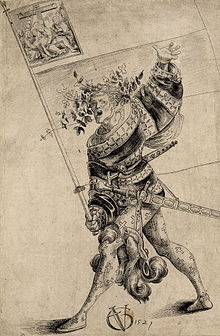
The 26 cantons of Switzerland are the member states of the Swiss Confederation. The nucleus of the Swiss Confederacy in the form of the first three confederate allies used to be referred to as the Waldstätte. Two important periods in the development of the Old Swiss Confederacy are summarized by the terms Acht Orte and Dreizehn Orte.

The canton of Uri is one of the 26 cantons of Switzerland and a founding member of the Swiss Confederation. It is located in Central Switzerland. The canton's territory covers the valley of the Reuss between the St. Gotthard Pass and Lake Lucerne.

The Federal Charter or Letter of Alliance is one of the earliest constitutional documents of Switzerland. A treaty of alliance from 1291 between the cantons of Uri, Schwyz and Unterwalden, the Charter is one of a series of alliances from which the Old Swiss Confederacy emerged. In the 19th and 20th century, after the establishment of the Swiss federal state, the Charter became the central founding document of Switzerland in the popular imagination.

Obwalden or Obwald is one of the 26 cantons forming the Swiss Confederation. It is composed of seven municipalities and the seat of the government and parliament is in Sarnen. It is traditionally considered a "half-canton", the other half being Nidwalden.
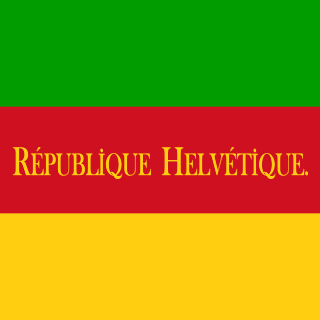
The Helvetic Republic was a sister republic of France that existed between 1798 and 1803, during the French Revolutionary Wars. It was created following the French invasion and the consequent dissolution of the Old Swiss Confederacy, marking the end of the ancien régime in Switzerland. Throughout its existence, the republic incorporated most of the territory of modern Switzerland, excluding the cantons of Geneva and Neuchâtel and the old Prince-Bishopric of Basel.
On 26 June 1964, Swiss Post introduced postal codes as the third country after Germany (1941) and the United States (1963).
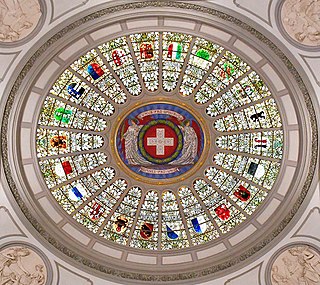
Each of the 26 modern cantons of Switzerland has an official flag and a coat of arms. The history of development of these designs spans the 13th to the 20th centuries.

The Old Swiss Confederacy began as a late medieval alliance between the communities of the valleys in the Central Alps, at the time part of the Holy Roman Empire, to facilitate the management of common interests such as free trade and to ensure the peace along the important trade routes through the mountains. The Hohenstaufen emperors had granted these valleys reichsfrei status in the early 13th century. As reichsfrei regions, the cantons of Uri, Schwyz, and Unterwalden were under the direct authority of the emperor without any intermediate liege lords and thus were largely autonomous.

Districts of Switzerland are a political subdivision for cantons. In the federally constituted Switzerland, each canton is completely free to decide its own internal organisation. Therefore, there exists a variety of structures and terminology for the subnational entities between canton and municipality, loosely termed districts. Most cantons are divided into Bezirke. They are also termed Ämter, Amtsbezirke, district or distretto. The Bezirke generally provide only administration and court organization. However, for historical reasons districts in cantons Graubünden and Schwyz are their own legal entities with jurisdiction over tax and often have their own Landsgemeinde.

During the French Revolutionary Wars, the revolutionary armies marched eastward, enveloping Switzerland in their battles against Austria. In 1798, Switzerland was completely overrun by the French and was renamed the Helvetic Republic. The Helvetic Republic encountered severe economic and political problems. In 1798 the country became a battlefield of the Revolutionary Wars, culminating in the Battles of Zürich in 1799.
The Swiss Confederation comprises the 26 cantons of Switzerland.

The Old Swiss Confederacy or Swiss Confederacy was a loose confederation of independent small states, initially within the Holy Roman Empire. It is the precursor of the modern state of Switzerland.
The Society for Art History in Switzerland is a Swiss learned society dedicated to promoting the understanding of Swiss art history and particularly of Swiss topography of art, including the study and maintenance of Swiss cultural heritage sites. The society, founded in 1880, publishes a wide range of monographs, guides, and inventories. These include the series Art monuments of Switzerland, which includes more than one hundred volumes, the first of which was published in 1927. It also publishes the quarterly journal Kunst und Architektur in der Schweiz.

Rapperswil is a former municipality and since January 2007 part of the municipality of Rapperswil-Jona in the Wahlkreis (constituency) of See-Gaster in the canton of St. Gallen in Switzerland, located between Obersee and the main part of Lake Zurich.
The Kyburg family was a noble family of grafen (counts) in the Duchy of Swabia, a cadet line of the counts of Dillingen, who in the late 12th and early 13th centuries ruled the County of Kyburg, corresponding to much of what is now Northeastern Switzerland.

Rathaus Rapperswil is the former Rathaus of the city government of medieval town of Rapperswil, Canton of St. Gallen in Switzerland. Today, the building houses a café and restaurant, the city archives and a collection of stained glass windows, silverware and paintings. The building and the city archives are listed in the Swiss inventory of cultural property of national and regional significance.

The French invasion of Switzerland occurred from January to May 1798 as part of the French Revolutionary Wars. The independent Old Swiss Confederacy collapsed from the invasion and simultaneous internal revolts called the "Helvetic Revolution". The Swiss ancien régime institutions were abolished and replaced by the centralised Helvetic Republic, one of the sister republics of the French First Republic.
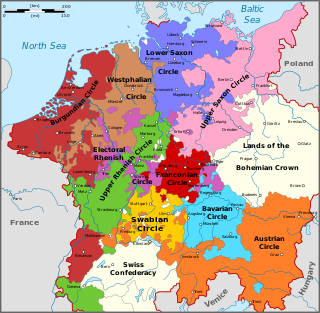
When the Imperial Circles — comprising a regional grouping of territories of the Holy Roman Empire — were created as part of the Imperial Reform at the 1500 Diet of Augsburg, many Imperial territories remained unencircled.
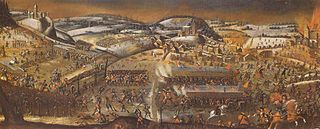
The First War of Villmergen was a Swiss religious war which lasted from 5 January until 7 March 1656, at the time of the Old Swiss Confederacy. On one side were the Protestant cities of Zürich and Bern, on the other the Catholic cantons of Central Switzerland. The Protestants tried to break the political hegemony of the Catholics, that had been in existence ever since the Second Kappel Landfrieden of 1531. The casus belli was the expulsion and execution of Protestants from the Schwyz commune of Arth. The Zürcher unsuccessfully besieged the Central Swiss-allied city of Rapperswil and thereby drove their forces together. The Bernese were defeated and repelled in the First Battle of Villmergen. The Third Landfrieden ended the conflict and restored the pre-war balance of power.
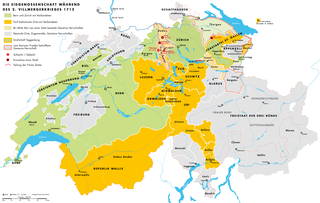
The Toggenburg War, also known as the Second War of Villmergen or the Swiss Civil War of 1712, was a Swiss civil war during the Old Swiss Confederacy from 12 April to 11 August 1712. The Catholic "inner cantons" and the Imperial Abbey of Saint Gall fought the Protestant cantons of Bern and Zürich as well as the abbatial subjects of Toggenburg. The conflict was a religious war, a war for hegemony in the Confederacy and an uprising of subjects. The war ended in a Protestant victory and upset the balance of political power within the Confederacy.

